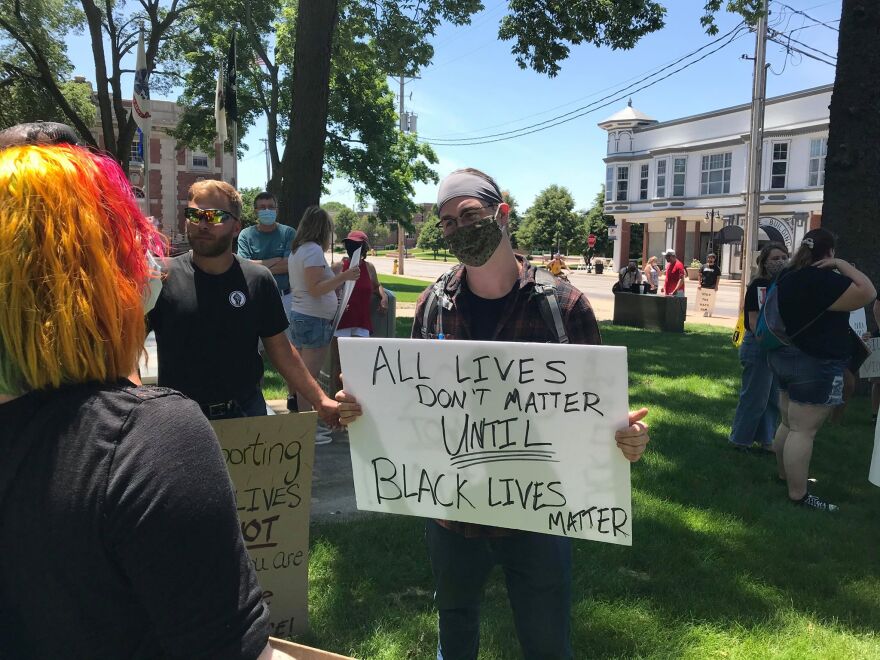State Sen. Kimberly Lightford says she is overwhelmed with emotion these days.
The majority leader from Maywood was inaugurated more than two decades ago as Illinois’ youngest – and only African American woman – senator. She’s struggled working toward legislation that would help her community, one that’s been hit particularly hard recently.
In the past few months, African Americans have died at a much higher rate from COVID-19 than others. In the past few weeks, there has been a series of killings of black people caught on video or at the hands of police. In the case of George Floyd, it was both.
Since a white Minneapolis police officer crushed the life out of Floyd with his knee, the nation and towns, large and small in Illinois, have been embroiled in weeks of protests – some peaceful, some accompanied by violence and looting.
Lightford has been in the streets rallying. The moment has managed to create hope, she says, and a shot at addressing issues, including, but not exclusively, criminal justice reform. Employment. Economic development. Education, to name a few.
“I feel that this may be the only time that I've witnessed in my lifetime that we really have a chance to impact positive change in a very significant, meaningful way,’’ she said on a recent afternoon after a Illinois Legislative Black Caucus Day of Action to call for justice for black coummunities.
She is not alone in her perception that this is a unique moment. Maudlyne Ihejirika is a columnist at the Chicago Sun-Times. She writes about issues relating to the city’s black and brown communities.
“We have never seen the sort of groundswell that we have seen in the wake of the George Floyd murder. And murder is indeed what it was. I think what was different is that the nation was forced to watch the brutality and inhumanity of a human being being killed on video, on TV, if you will, right before our very eyes,’’ she said. “And this particular footage was beyond anything that any of us have witnessed before. We got to see it in excruciating detail.”

This time, calls of Black Lives Matter are coming from broad, multiracial coalitions in a climate of frustration over what some consider to be the racist actions of President Donald Trump.
That’s the context, said Knox College Professor Fred Hord, a historian who is chair of Africana Studies at the Galesburg school and a longtime activist.
Hord said he is encouraged by hearing white voices added to the outrage in this struggle.
“The violence against not just black man but black people, goes back to 1641 when slavery for life, chattel slavery connected, the color started in Virginia,’’ he said. “In my lifetime, I've seen so much violence, perhaps not a police officer, or often a police officer, I'm old enough to remember and Emmett Till.”
Till was a black teen from Chicago who in 1955 was killed when he was brutally beaten to the point of disfigurement, allegedly because he had flirted with a white woman at a grocery store
Maudlyne Ihejirika likens that case to the Floyd killing. “The last time we witnessed this, it was an entire nation confronting the reality of racism in this country, through the battered and tortured face and body of a 14 year old Chicago boy,’’ she said. “And that, as you know, has been called the linchpin, the defining moment. The moment that just was the tipping point of the civil rights movement and that 1955 murder and the image that gripped a nation led to a nine year battle for the Civil Rights Act of 1964.

The Till murder caught the attention of all races as the Floyd case has done. The sites of Illinois’ Black Lives Matter protests have been in African Communities, but they’ve also occurred in predominantly white suburbs and even small downstate, mainly white communities,that have known racial strife. Those communities include Benton, a southern Illinois town that was the site of a Ku Klux Klan rally in 1995 and Pekin, whose newspaper once had an owner who was a Klan member. Michelle Mueller Tehuex is the former editor of Pekin Daily Times.
“There are a lot of people who claim there was a sign saying that black people need to be out by sundown. I've never been able to prove was that sign existed. A lot of people have said it did exist, but we never found photographic evidence,” she said.
No longer in journalism, she joined a recent rally, which she estimates 175 to 200 people —mostly white — attended.
" I do think that we are seeing a change. And it's not going to be some magic thing where in the next 10 years, everything is going to be perfect,'' she said. "For the first time in my life, I'm seeing nice white ladies with a little bit of money in a small town. really, truly, really, truly being outraged by the way black people are being treated."

Lightford is brought to tears at the thought of progress in issues of race.
“We're finally at a point now where all races they see what we're talking about to some degree and they see the democracy that’s needed and they see the injustices and the inequities, and I'm just grateful that they're coming forward at this time, I really am.”






